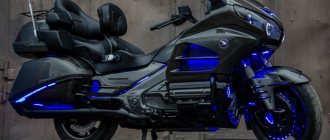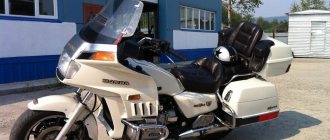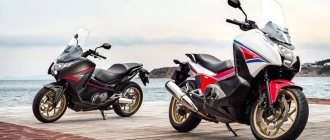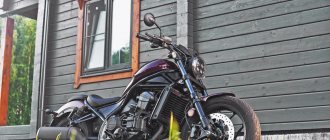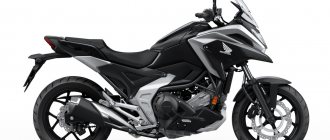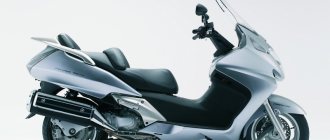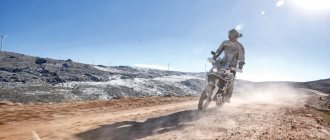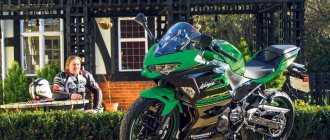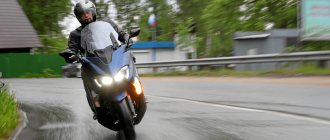Velvet revolution: test drive Honda Gold Wing Tour DCT 2021
The history of the Honda Gold Wing motorcycle began in 1974. In those days, fairings had not yet come into use on touring motorcycles, but the liter boxer “four” at that time looked almost cooler than the “six” today. Here it is, the ideal touring motorcycle - huge, high-torque and comfortable.
It was these three words that determined the vector of development of the “golden wings” family for more than forty years. And even though the times when the Japanese shocked the world with the wonders of their engineering reached our country only as an echo: in the form of used GL1500 and GL1800, this was enough to once and for all gain a foothold in the minds of compatriots as the motorcycle of the son of his mother’s friend.
Video review of the new Honda Gold Wing Tour 2018:
Do not laugh. Any person at least somewhat connected with motorcycles has probably heard from a person far from the topic of motorcycles about “this one, you know, huge, with music and lights, so beautiful!” And even though the Golda has competitors in the form of the HD Ultra Limited and the BMW K1600GTL, they will talk to you with genuine delight about it, a device that is too popular in our latitudes.
The new “Golda” is so much smaller than the old one that from certain angles it looks more like “Paneuropa”
The success of the Japanese motorcycle, created for the USA (and until recently even produced there), in our latitudes was obvious. We also love everything big and expensive: more than 400 kilograms of mass, 6 cylinders, 1.8 liters of working volume (leave the measurements in “cubes” to scooterists!), an incredible number of options and cases that even a not too finely chopped person will fit into – a super motorcycle for serious adults and those who want to appear as such.
Moreover, “Golda” has been developing exclusively in one direction for forty years - becoming larger, heavier, more powerful and more functional. It is not surprising that the emergence of a new generation (the previous one, let me remind you, appeared already in 2000) simply drove everyone involved and concerned crazy: is it even possible to create a motorcycle cooler than the Gold Wing 1800?
There are only two rear lights, there is not even a brake light on the trunk. But owners can easily turn the tourer into a bagger
Today's Honda is a game against the rules and canons. A striking example is the Africa Twin: in a world where large tourenduros have grown to 1200-1300 cc, and medium-sized ones have swelled to 800-900, the Japanese have produced an absolutely classless “liter”. Too simple and light to be called a large-capacity car, too fast and progressive to compete with mid-sized ones, and the only “automatic” transmission in the class has become a real challenge.
Why the new Honda GoldWing 2018 motorcycle can be called a legend
EG.RU conducted a test drive of a bike that claims to be the best luxury tourer in the world
Subscribe and read Express Newspaper in:
The Honda GoldWing motorcycle has been in production since 1975, but it first acquired its current concept of “lots of plastic, big suitcases” in 1980 in the GL1100 Interestate version. Since then, there have been three generations: GL1200 in ’84, GL1500 in ’88, and finally GL1800 in 2001, which became the longest-lived.
The first rumors about the new Golda began to spread in 2014, but in 2015 we were shown only anniversary versions of the same old GL1800. By this time, the ultra-modern BMW K1600GTL was already on sale on the market, which had adaptive xenon light, a powerful engine and a traction control system in its arsenal. And this is not to mention a considerable number of small modern gizmos such as an electric windshield and ESA suspension. Against this background, the relatively new GolgWing, whose only feature was a built-in airbag, already seemed like an atavism.
But 2021 comes, and in the fall, at the exhibition in Milan, Honda throws off the covers on one of the most anticipated motorcycle premieres of the year. The absolutely new GoldWing is presented to the eyes of the press: the linkage front suspension, a huge display in place of the dashboard and slightly smaller dimensions compared to its predecessor catch the eye. And (fanfare sounds), finally, an automatic transmission bursts into the narrow world of premium asphalt tourism. The standing ovation is over, we are waiting for a copy for a test drive.
Honda GoldWing 2018. Source: ©Ilya Korshunov/KP
We decided to test a motorcycle that claims to be the best luxury tourer in the world. It should be noted that this is the most expensive and packaged version with the Honda DCT robotic gearbox. The first sensations while I was driving it from the Honda office in the Moscow region to the office parking lot in Moscow were pure delight. On paper, this is a heavy intercontinental iron (383 kg of curb weight), less than nine centimeters wide, but the size is not felt on the move. The new “Golda” shifts perfectly when changing lanes, turns into corners like an ordinary road driver, and the completely redesigned engine demonstrates excellent acceleration dynamics and elasticity. A big revelation was the behavior of the motorcycle in a traffic jam at the entrance to the city: despite its considerable width, weight and non-removable side cases, you calmly ride in heavy traffic, forgetting that there is a pannier system attached to the rear, with a total capacity of the trunk in a compact class car. And it has also become easier to move it in the parking lot. The understanding comes that the attempt to make a huge motorcycle compact (as much as possible for this class) by Honda engineers was obviously successful: the center of gravity is low, the dimensions are perfectly felt. Compared to the old Golda, driving the new Gold Wing in a city clogged with cars has become much easier.
Honda GoldWing 2018. Source: ©Ilya Korshunov/KP
So, let's take a closer look at the new product. The new GoldWing is not a deep restyling, but a completely new motorcycle. The changes affected literally everything, but the most interesting thing was the front suspension and automatic transmission. The telescopic fork is a thing of the past, and its place is taken, already familiar to the motorcycle world from the BMW K1600, by a lever system based on a single shock absorber hidden inside the motorcycle. One of the undoubted bonuses of this system is the absence of dives when braking.
The motorcycle, when you press the front brake, sits down a little on both wheels and slows down amazingly: previously only people from Bavaria could stop like that. The new brake system, D-CBS, or, more simply put, an electronic brake force distribution system that came from the automotive world, helps you stop smoothly and safely. Coupled with the new motor and frame, it all works simply amazing. Excellent (for such an elephant, of course) dynamics, complemented by a high-quality chassis and brakes, returns the proud title of “Motorcyclist” to the Goldovods.
The motorcycle leans very deeply without any serious effort. While riding around Moscow, I caught the asphalt with the running board several times at butterfly junctions, although on the old version it would never even have occurred to me to take these turns at such a speed. Almost perfect. Almost - because the suspension is visible from the cockpit. The struts stick out right between the steering wheel and the dashboard, moving up and down when the suspension is working. It looks a little strange, but BMW figured out how to avoid such a misunderstanding, and in Honda, it seems to me, the engineering works no worse.
Honda GoldWing 2018. Source: ©Ilya Korshunov/KP
Several years ago I had the opportunity to drive one of the first Hondas with an automatic transmission, it was a VFR 1200 - the gearbox, and the idea in general, seemed absolutely dull and dead-end to me at that time. After that there were several more options - on the NC750, and in 2021 on the new AfricaTwin. Apparently, the moment had just come when Honda realized that the balance of convenience and precision of gearbox control had finally been caught. If the first few kilometers the robot somewhat frightened me with its unpredictability (how will it understand that I need to go down sharply?), then everything fell into place. He understands when to go down and when to go up.
Sometimes the electronic brains get a little stuck: for example, when, after dynamic driving in traffic, you start to drive calmly, but the computer still thinks that we need to get out and changes gears in the upper rev range. But after a couple of switches everything goes away and the robot quickly adapts. If you really want, you can use the buttons to change gears manually (I used this opportunity solely to study the function; in real life it is difficult to imagine why it is needed). For ease of starting on highly inclined surfaces, there is a Hill Start Assist system. When driving through hilly cities like Istanbul, it is definitely a must have. And parking on a slope, without fear of the motorcycle rolling away, will help with the handbrake. Reverse gear has not gone away either - it is controlled from the remote control on the steering wheel.
The electronics of the new “Golda” are a separate story - everything is as cool as it can be in 2021. A description of everything that is there will require a separate narrative, so I’ll only tell you about the main thing: electronic adjustment of suspension damping modes, traction control and traction control modes, all this is controlled from a convenient joystick in the center of the tank and from the left remote control, and the information is displayed on the dashboard unearthly beauty.
Naturally there is Bluetooth. Well, complete keyless - starting, opening/closing the motorcycle, panniers - all without a key. But the most important thing is support for Apple CarPlay (it seems like they promise to add Android Auto, but this is not certain). Even the products of the best motorcycle navigation companies on the market, such as Garmin and TomTom, cannot compete with the offline mode of Google Maps in a smartphone. What can we say about a device with an Internet connection: with online road information and always up-to-date cartography. Since Google Maps became available for CarPlay (you need to update iOS on your iPhone to version 12), excellent navigation right in the center of the dashboard is just a bomb and a definite killer feature.
Honda GoldWing 2018. Source: ©Ilya Korshunov/KP
You can write about the audio system for a long time, or you don’t have to write at all: unassuming listeners will be more than satisfied with it, but demanding listeners will need tuning of the amplifier and acoustics. Music from the speakers in a closed helmet is perfectly audible up to 100 kilometers per hour, up to 140 it’s just audible. Those who like to drive faster (but not faster than 180 km/h, now this is the maximum speed for the non-Japanese version with DCT) and with music will need a headset in their helmet.
Passenger comfort has remained unchanged: everything is cool and convenient, the only question arises about the presence of a coffee machine (and really, Honda, isn’t it time to build it in?). But there are questions about luggage. While the side panniers have sufficient capacity, the central pannier, apparently in the process of aerodynamic improvements, was cut. Now two large helmets like Schuberth C4 do not fit together, so you will have to take this factor into account when choosing helmets for shared trips...
There are also many questions about maintainability - it seems that without a dealer scanner it will be possible to change only the oil with a filter and pads, but what to do in places where there was no smell of a Honda dealer?
The days allotted for the test drive flew by. Unfortunately, we weren’t able to travel far, but even those modest kilometers that we managed to accumulate around Moscow allow us to say: it looks like Honda didn’t delay the update for so long for nothing. It’s easy to kill the goose that lays the golden eggs along with customer trust, but regaining that trust is difficult. The new motorcycle, without any doubt, turned out to be a worthy successor and, quite possibly, following its predecessor, will receive the honorary title of Legend.
Korshunov Ilya
motorcycles photo eg.ru exclusive
Bad weather
An attentive reader of the previous paragraphs may think that the BMW has better wind protection. This reader will be right, the BMW K1600B Grand America is a really big motorcycle that protects the rider well from the elements - wind, land and water. The new Honda Goldwing Tour is thinner and smaller than previous versions, and therefore has slightly less wind protection. However, we would like to mention separately: there is no need to be afraid of getting wet on the Golda, it perfectly deflects the wind away from the rider.
The wind deflectors of both motorcycles are electronically adjustable. On a BMW it rises a little higher in the rider’s field of vision, but it also provides excellent wind protection, because it simply becomes quiet in the helmet. And in order not to suffocate on a hot day, all K1600 have special folding sections of plastic directly under the mirrors, which allow you to direct a small stream of air into the beak. This is certainly not a reason to buy this particular bike, but it is a pretty smart feature, especially on a bike that can completely rob the rider of the wind.
On the other hand, the Gold Wing has a small valve above the dash that is supposed to direct airflow towards the rider when the windshield is up. True, on our copy the latch that opens this valve was jammed (by the way, the glove compartment opening button was jammed in the same way), so we were not able to fully evaluate the operation of this function.
Luxury tourers
In the luxury tourer class, interesting motorcycle features are quite expected, and they are here.
Everything, including satellite navigation, electric windshield, electronic suspension adjustment, cruise control, traction control, combination brakes and ABS. Golda has all these features as stock, and there are several upgrade packages for BMW. But the presence of the same functions does not mean that they work the same.
Take, for example, heated seats and handles. BMW's handles heat up faster and are so hot at maximum that they are impossible to hold. Both have large central panniers (although the Honda pannier didn’t fit two integrals), but the BMW pannier is made of a higher quality, it has a felt carpet, automatic lighting and a 12-volt socket. Honda's panniers are bare plastic, and feel rather flimsy compared to BMW's plush and substantial luggage system.
At the same time, the Honda Goldwing has additional compartments for storing various small items, including a glove compartment under the tidy and a small niche near the driver’s right knee. The central glove compartment is equipped with a USB socket and a soft phone holder - this is clearly more convenient than putting the phone to charge in the right case of a BMW. It’s quite strange that in that glove compartment, near the driver’s knee, there is a button that opens the gas tank cap. Something like a "Goldberg machine" for refueling - a device that performs a simple function in a complex way and at the same time prevents the gas tank from opening while driving.
There is one thing on the BMW K1600B that is worthy of all praise - a headlight that illuminates the corner. BMW's Adaptive Xenon headlight uses a servo-driven movable mirror that changes the direction of the beam based on the angle of inclination and speed sensor readings. 65 kilometers of complete darkness turned out to be a good test of this function, and the test was passed perfectly. It works disarmingly well, improving speed and ride quality in the dark. The bright LED headlight of the Golda is good in itself, but in comparison with the magnificent light the K1600 loses outright.
Where BMW falls behind is in the dashboard, which remains at 2011 levels. One of the important updates to the Gold Wing - 2021 is the tidy, which has been simplified and polished compared to the previous version. The crown jewel of this device is the 7-inch full-color TFT screen, next to which the BMW display looks dull and backward. Both bikes have the same huge (and equally intuitive) menu, the same controls, and as with any complex interface, you need to put in the same many kilometers to figure it all out and get used to it.
Engine
This is not to say that the BMW K1600B engine (1649 cc) is small, but it is certainly remote. Although this inline-4 has 184cc less than Honda's boxer, it somehow produces 26 more hp. more and almost the same amount of torque - 143 N*m versus 146 for the Golda. The rower also sounds more pleasant at high speeds and spins a couple thousand more. It's a much more dynamic and enjoyable engine, but perhaps that's not the point in this class of bike.
The Honda Goldwing Tour engine has its own magic - it is designed for a different type of ride. It's been thoroughly and comprehensively redesigned for 2021, and delivers 92 percent of its torque from near idle. This means that you can engage the top gear and almost never shift down, which, by the way, is good, because the Gold Wing gearbox was sometimes unclear. Several times the paw did not return to its place after engaging the next gear. The BMW had no such problems, partly because it has crisper, smoother shifts, and partly because it has an electronic shift assist feature called a quickshifter. This feature is wonderful, but comes with the optional Premium Package, which also includes keyless entry, additional LEDs, an alarm and other extras.
BMW K1600B Grand America
The BMW K1600B is practically a twin of the Golda in terms of specifications: a 6-cylinder engine, a funny front fairing design, sweeping lines and a lot of touring features. The latest version of the K16B - Grand America - is equipped with a central trunk, built-in GPS, heated seats for the driver and passenger. The most significant difference between them is that everyone is talking about the “Gold” and it’s as if no one has heard about the new luxury tourer from the Bavarians. So we have planned a route of approximately 1600 km, during which we will learn more about these motorcycles and reveal their features that are important for this class of motorcycles.
Battle for luggage
The first thing that is important when traveling is your luggage. And here Honda played to its detriment, sacrificing part of the Golda’s usual colossal luggage capacity to make the motorcycle more compact. Now it has two side cases with a capacity of 30 liters and a central case with a volume of 50 liters, together giving 110 liters of luggage (not counting the glove compartment in the beak, to which we will return). The BMW holds 123 liters - 37 in each of the side cases and 49 in the central one. Honda's electric saddlebag locks are opened by pressing a button, while BMW's system is more traditional, with a key.
From a practical point of view, the BMW luggage system turned out to be better. A motorcycle overall from Aerostich fit into the side case, and two Shoei Neotec fit into the central case. At Honda, we weren't able to distribute the load like that. It would seem that there is a difference of 13 liters, but here the Germans clearly calculated everything better. For soft loads, the Honda center case turned out to be more convenient because it has higher sides at the bottom, in contrast to the half-length case of the K1600. By the end of the day, we also began to like the mechanical locks of the BMW panniers more, as they opened and closed more clearly.
Which one should you buy?
Despite the fact that these motorcycles are roughly speaking on the same supermarket shelf, there is a significant difference between them. The engine power, tank capacity (26 liters versus 21) and luggage capacity speak in favor of BMW. Also in its favor is the fact that some functions on it are optional and their absence makes the price of the new bike lower.
Buying a BMW K1600B Grand America seems like a smart decision, but it remains difficult to come to terms with its stance, because without optional platforms the thought of driving it for a couple of hundred kilometers without stopping must be scary. The Gold Wing is more comfortable, more majestic and better suited for long and long journeys, just like its intended purpose. Slight disappointment was caused by the unclear operation of the gearbox and jammed latches of the glove compartment and airflow, but overall the new “Golda” is a brilliant heir to its glorious ancestors.
Again, if a wonderful engine, quickshifter and other features attract you, there is always the BMW K1600GTL, which was not tailored to the tastes of the American public and therefore remained a purebred Aryan - strict, practical and slightly defiant.
Our clear conclusion from the comparison is that six-cylinder tourers are more than “V-twin plus 4 cylinders.”
Comfort
Beauty is in the eye of the beholder, but comfort is in the buttocks of the sitter, as they say.
Therefore, it is impossible to objectively judge which one you will like best. Fortunately, the difference is easy to identify and explain. The new Honda Goldwing Tour has a wonderfully neutral riding position - upright, feet slightly behind the knees, hands easily reaching the handlebars in a bent position. The seat is wide, but doesn't feel like a big round chair like some tourers. Overall, the Golda is a relaxed and impressive mileage-eating machine.
Honda Goldwing Tour
The BMW K1600 Grand America is also very comfortable, but has slightly more distinctive ergonomics. Compared to the Golda, the BMW more strongly evokes the feeling that you are not ON the motorcycle, but IN it. The seat seems lower (well, actually, our example of the motorcycle actually has a seat lowered by 3 cm), and the footpegs are higher. Although the difference is quite small, it is felt that this device is the closest relative of the K1600GTL - more of a sports tourer than a cruiser with a central pannier. Perhaps the Bavarians, in anticipation of the American public, made the steering wheel slightly pretentious, bending the handles closer to the seat.
BMW K1600B Grand America
Another nod to American ergonomics is the optionally installed platforms for those who like to straighten their knees - which, by the way, is quite reasonable, taking into account the rather high footrests and low seat.
